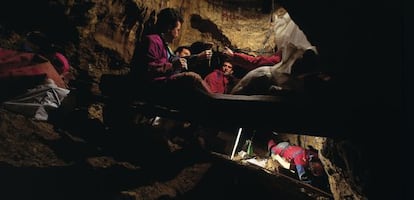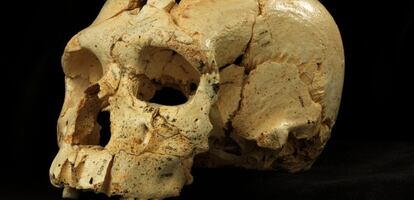Skulls discovered at key Spanish site point to Neanderthals’ origins
Unearthing of 430,000-year-old fossils at Atapuerca sheds light on our cousins’ ancestors

No paleontology site in the world comes even close to containing such a wealth of information as the Sima de los Huesos (Bone Pit) in Atapuerca, in the northern Spanish province of Burgos.
If just one hominid tooth represents a major discovery at any site, this cave has yielded 17 skulls, some of them intact, and nearly 6,500 fossils dating back 430,000 years.
“The men at Sima de los Huesos are the beginning of Neanderthal evolution, they are the oldest in the lineage,” explains Ignacio Martínez, a lecturer at Alcalá de Henares University and a researcher at Atapuerca.
Sima de los Huesos has been described as “a paleontological treasure”
“The traits of their faces and their teeth are typical of Neanderthals, while the shape of their skulls is still archaic,” he continues. “Everything suggests that the evolution towards the Neanderthal lineage is related to chewing; we are seeing modifications relating to the intensive use of their incisors, as though they used their teeth as a third hand to help with multiple tasks.”
On Friday, the team published a paper explaining its discoveries in US journal Science. The article reviews the latest discoveries at Sima de los Huesos, including seven new skulls, which bring the total to 17.
The journal notes that this is the greatest collection of ancient human fossils ever recovered at a dig, and that their analysis sheds light on the origin and evolution of the Neanderthals.

“Based on their morphology, we think that the people of Sima de los Huesos were part of the Neanderthal lineage, although they don’t have to necessarily be direct ancestors of the typical Neanderthals,” writes Juan Luis Arsuaga, co-director of the dig.
Humans were already in Atapuerca 1.2 million years ago, as shown by fossils found at a spot known as El Elefante. Around 500,000 years ago, a group settled at Sima de los Huesos. This population was “like a maternal aunt to subsequent Neanderthals, not necessarily their mother,” says Martínez. “What is clear is that there was not one single human species at the time, but several coexisting in that territory.”
Neanderthals lived in Europe from 200,000 years ago until 30,000 or 40,000 years ago, when they became extinct. Their territory had been taken over by modern humans who came in from Africa and the Middle East.
While there was some interbreeding, “both groups already had several incompatible traits,” notes Jean Jaques Hublin, an expert at the Max Planck Institute of Evolutionary Anthropology, in Science magazine.
Hublin described Sima de los Huesos as “a paleontological treasure.”
Reconstructing the puzzle
“The fossils at Sima de los Huesos… It’s like having 28 puzzles made up of 206 pieces each,” says Ana Gracia, a specialist in reconstructing the bones of the Atapuerca fossil collection. There are at least 28 individuals whose bones have been partly recovered from the site, and each human skeleton has 206 bones.
Gracia, a researcher at Alcalá de Henares University, has spent nearly 30 years working at Sima de los Huesos, and she describes the hominids as her “other family.” She has seen the trove grow from the initial dozen found in the 1980s to more than 6,500 today.
“You try to keep track of all the fossils in your head to figure out who each one might belong to,” she explains.
Tu suscripción se está usando en otro dispositivo
¿Quieres añadir otro usuario a tu suscripción?
Si continúas leyendo en este dispositivo, no se podrá leer en el otro.
FlechaTu suscripción se está usando en otro dispositivo y solo puedes acceder a EL PAÍS desde un dispositivo a la vez.
Si quieres compartir tu cuenta, cambia tu suscripción a la modalidad Premium, así podrás añadir otro usuario. Cada uno accederá con su propia cuenta de email, lo que os permitirá personalizar vuestra experiencia en EL PAÍS.
¿Tienes una suscripción de empresa? Accede aquí para contratar más cuentas.
En el caso de no saber quién está usando tu cuenta, te recomendamos cambiar tu contraseña aquí.
Si decides continuar compartiendo tu cuenta, este mensaje se mostrará en tu dispositivo y en el de la otra persona que está usando tu cuenta de forma indefinida, afectando a tu experiencia de lectura. Puedes consultar aquí los términos y condiciones de la suscripción digital.
Últimas noticias
Cubans look to Venezuela fearfully after Trump’s incursion: ‘We could be next’
The operation in Venezuela to capture Maduro threatens to widen the cracks in the MAGA movement
Trump clarifies who is ultimately in charge in Venezuela: ‘Me’
Maduro pleads not guilty before the federal court in New York: ‘I am still the president of Venezuela’
Most viewed
- Alain Aspect, Nobel laureate in physics: ‘Einstein was so smart that he would have had to recognize quantum entanglement’
- Gilles Lipovetsky: ‘If you want to live better and fall in love, take Prozac, don’t look to philosophy’
- Alvin Hellerstein, a 92-year-old judge appointed by Bill Clinton, to preside over Maduro’s trial in New York
- Cuba confirms death of 32 of its citizens in the US attack against Venezuela
- Why oil has been at the center of Venezuela-US conflicts for decades








































